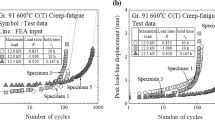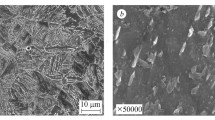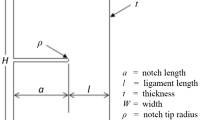Abstract
This paper examines the effects of crack front curvature on the fracture toughness (crack-tip opening displacement) of A707 steel. Fracture mechanics specimens, in which the radii of curvature of the crack fronts are controlled in an effort to simulate potential variations in crack front profiles in fracture experiments, were produced by machining and fatigue pre-cracking. Three-point bend crack-tip opening displacements (CTODc) were measured in accordance with the ASTM E-1290 code. The results show that the critical CTODc increases with increasing crack front curvatures between 0.05 and 0.17 mm−1. In all cases, stable crack growth and final catastrophic failure of the specimens are found to occur by transgranular ductile dimpled fracture, in which the ductile dimples are nucleated around MnS or Al2(Mg)O3 inclusions. The implications of the results are discussed for the measurement of critical CTODc in specimens with varying levels of crack front curvature.
Similar content being viewed by others
References
ASTM E 1290-93 (1993). Standard Test Method for CTOD. American Society for Testing and Materials, Philadelphia, PA.
BS 7448-1 (1991). Fracture Mechanics Toughness Tests: Method for Determination of KIC, Critical CTOD and Critical J values of Metallic Materials. British Standard Institute.
Burton, W.S., Sinclair, G.B., Solecki, J.S. and Swedlow, J.L. (1984). On the implications for LEFM of the threedimension elastic-plastic flow. International Journal of Fracture 25, 3–32.
Crouch, B.A. (1991). The Effects of crack front curvature and side-grooving on three point bend specimen fracture toughness measurements. International Journal of Fracture 52, 275–292.
Crouch, B.A., Bender, R.G. and Williams, J.G. (1992). Investigation of notching techniques for fracture toughness measurement in amorphous nylon. Engineering Fracture Mechanics 41, 49–57.
Cruse, T.A. and Vanburen, W. (1971). Three-dimension elastic analysis of a fracture specimen with an edge crack. International Journal of Fracture 7, 1–15.
Freed, C.N. Good, R.J. and Judy, R.W., Jr. (1971). Comparison of fracture toughness test procedures for aluminum alloys. Engineering Fracture Mechanics 2, 359–371.
Folias, E.S. (1990). On the three-dimensional bending theory of cracked plates. International Journal of Solids and Structures 25, 497–513.
Gao, X., Ruggieri, C. and Dodds, R.H. JR., 1998. Calibration ofWeibull stress parameters using fracture toughness data. International Journal of Fracture 92, 175–200.
Grandt, A.F. Jr., Perez, R. and Tritsch, D.E. (1984). Cyclic growth and coalescence of multiple fatigue cracks. Advances in Fracture Research (Fracture 84), Proceedings of the 6th International Conference on Fracture (ICG6) 2, 1571–1578.
Heath, B.J. and Grandt, A.F. (1984). Stress intensity factors for coalescing and single corner flaws along a hole bore in a plate. Engineering Fracture Mechanics 19, 665–673.
Hicks, M.A. and Pickard, A.C. (1982). Comparison of theoretical and experimental methods of calibrating the electrical potential drop technique for crack length determination, International Journal of Fracture 20, 91–99.
Kishimoto, K., Soboyejo, W.O., Smith, R.A. and Knott, J.F. (1989). A numerical investigation of the interaction and coalescence of twin coplanar semi-elliptical fatigue cracks. International Journal of Fatigue 2, 91–96.
Macdonald, B. D. and Pajot, J.J. (1990). Stress intensity factor for side grooved specimens. Journal of Testing and Evaluation 18, 281–185.
Moran, P.M. and Shih, C.F., 1998. Crack growth and cleavage in mismatched welds: a micromechanics study using a cell model. International Journal of Fracture 92, 153–174.
Nikishkov, G.P., Heerens, J. and Hellmann, D. (1999). Effects of crack front curvature and solid grooving on CTOD δ5 and J-integral in CT and 3PB specimens. Journal of Testing and Evaluating (JTEVA) 27, 312–319.
Schwalbe, K,H. (1995). Introduction of δ5 as an operational definition of the CTOD and its practical use. Fracture Mechanics, ASTM STP 1256 26, 231–245.
Shih, C.F., DeLorenzi, H.G. and Andrews, W.R., (1977). Methodology for plastic fracture, International Journal of Fracture 13, 554–548.
Soboyejo, W.O., Kishimoto, K., Smith, R.A. and Knott, J.F. (1989). A study of the interaction and coalescence of two coplanar fatigue cracks in bending. Engineering Fatigue and Fracture of Materials and Structures 12, 167–174.
Soboyejo, W.O., Knott, J.F., Walsh, M.J. and Cropper, K.R. (1990). Fatigue crack propagation of coplanar semielliptical cracks in pure bending. Engineering Fracture Mechanics 37, 323–340.
You, C.P. and Knott, J.F., 1986. Effects of crack shape on fracture toughness in a high-strength structural steel. Engineering Fracture Mechanics 24, 291–305.
Author information
Authors and Affiliations
Rights and permissions
About this article
Cite this article
Zhou, J., Soboyejo, W. An Investigation of the Effects of Crack Front Curvature on the Crack-Tip Opening Displacement of A707 Steel. International Journal of Fracture 115, 287–305 (2002). https://doi.org/10.1023/A:1016316002733
Issue Date:
DOI: https://doi.org/10.1023/A:1016316002733




